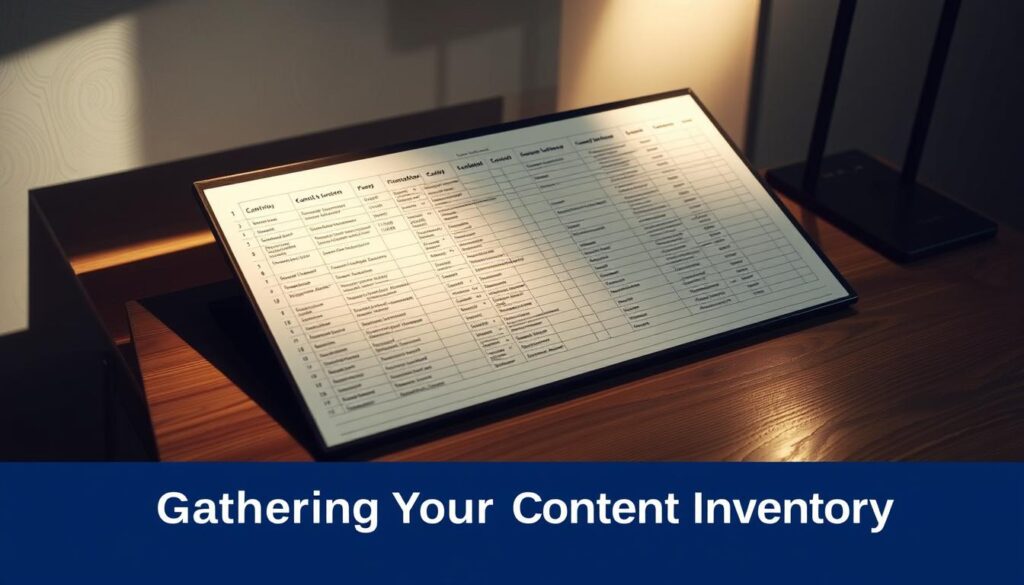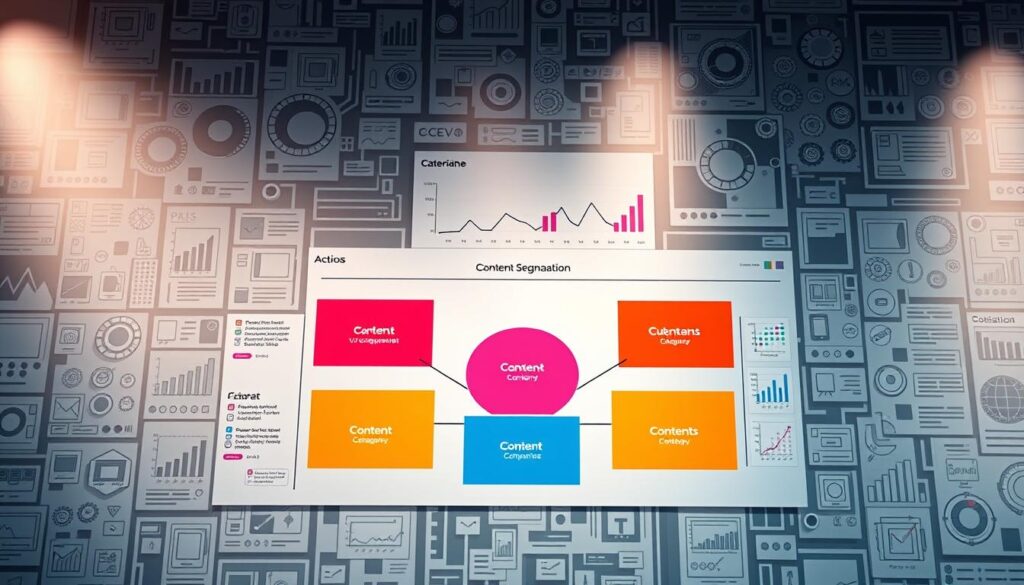Modern organizations struggle to maintain strategic alignment across growing digital libraries. With thousands of pages, posts, and assets requiring evaluation, traditional review methods often fail to address quality gaps or emerging opportunities. Automated solutions now offer a smarter approach to this challenge.
Advanced algorithms analyze semantic patterns and engagement metrics at scale, processing hundreds of documents in minutes. This method surpasses manual reviews by identifying subtle trends in user behavior and search performance. Machine learning models continuously refine their assessments, adapting to evolving digital marketing standards and audience preferences.
The results empower teams to prioritize high-impact updates. Companies gain clarity on which materials need optimization versus complete overhauls. Technical SEO factors like load speeds and mobile responsiveness get equal attention alongside qualitative elements such as tone consistency and information depth.
Leading enterprises report 42% faster decision-making cycles after implementing these systems. Resource allocation becomes more precise, with teams focusing efforts where they generate measurable returns. This strategic advantage proves critical in competitive markets where content relevance directly impacts brand authority.
Key Takeaways
- Automated analysis reduces audit timelines from weeks to hours
- Machine learning detects hidden patterns in engagement data
- Combined technical and qualitative evaluation improves SEO outcomes
- Dynamic prioritization guides efficient resource distribution
- Real-time insights support agile content marketing adjustments
Introduction to AI-driven Content Audits

As digital footprints expand, companies grapple with ensuring every webpage serves a strategic purpose. Manual evaluations struggle to keep pace with growing libraries, creating gaps in quality and relevance. Automated systems now bridge this divide through intelligent assessment frameworks.
Overview of Content Auditing
Content auditing systematically evaluates digital materials against performance benchmarks and organizational goals. Traditional approaches require weeks to review large inventories, often missing subtle patterns in user engagement. Modern solutions leverage crawling technology and machine learning to analyze technical SEO factors alongside semantic depth.
These tools score pages based on freshness, keyword alignment, and readability. For example, natural language processing identifies gaps in topic coverage, while metadata scanners check mobile responsiveness. This dual approach ensures both technical precision and audience-centric value.
Key Benefits for Modern Strategy
Automated evaluations reduce manual labor by 80% while improving accuracy. Teams gain prioritized recommendations, focusing efforts on pages needing updates versus complete rewrites. Real-time insights enable swift adjustments to marketing campaigns, aligning content with shifting audience needs.
Strategic advantages include identifying outdated materials before they impact search rankings. Organizations also improve ROI measurement by tracking how optimizations affect traffic and conversions. This proactive approach keeps digital assets competitive in dynamic markets.
Gathering Your Content Inventory

A thorough content audit relies on accurately mapping every webpage. Teams must catalog all digital assets to identify optimization opportunities and gaps in their strategy. This process forms the backbone of strategic improvements across a website’s entire ecosystem.
Using Sitemaps and SEO Tools
XML sitemaps provide structured blueprints of a website’s architecture, typically accessible via /sitemap.xml or robots.txt. These files list all pages and their relationships, offering crawl efficiency for search engines. Google Search Console supplements this data by revealing indexed URLs, though its 1,000-URL limit requires supplemental methods.
Third-party tools like Screaming Frog solve scalability challenges. Their crawlers analyze up to 500 URLs in free versions while integrating with analytics platforms. Advanced features pull data from Google Analytics and Ahrefs, creating unified dashboards for technical SEO metrics.
Organizing URLs with Spreadsheets
Structured spreadsheets transform raw URL lists into actionable insights. Columns should track publication dates, traffic statistics, and content categories. This organization helps teams:
- Prioritize high-traffic pages needing updates
- Identify duplicate or outdated materials
- Compare performance across content types
Automated systems enhance accuracy by syncing with Google Search Console via APIs. Real-time updates eliminate manual entry errors while providing current engagement metrics. This approach ensures no asset goes unexamined during strategic evaluations.
Defining Goals and Collecting Data

Successful content optimization starts by establishing clear benchmarks and systematic data aggregation. Teams must align their evaluation criteria with business priorities while capturing granular performance insights. This approach transforms raw statistics into actionable intelligence.
Setting Performance Metrics and KPIs
Quantifiable indicators like organic traffic volume and bounce rates reveal content effectiveness. Pages averaging below 100 yearly visits often signal relevance issues, while bounce rates above 70% suggest mismatched user intent. Comparing click-through rates against industry standards (5.17% for B2B vs. 11.43% for entertainment) highlights title and meta description weaknesses.
Dwell time measurements expose engagement gaps. Materials keeping visitors under 40 seconds typically lack depth or clarity. Combining these metrics with social shares and backlink profiles creates a 360-degree view of content value.
Identifying Outdated and Underperforming Pages
Data-driven prioritization flags pages needing immediate attention. Low-performing assets often exhibit:
- Declining search visibility over 6+ months
- Backlink profiles shrinking by 20% annually
- Conversion rates below site-wide averages
Integrating Google Analytics with webinar strategies enhances cross-channel insights. This methodology ensures teams focus resources on updates delivering measurable ROI rather than guesswork-driven revisions.
AI-driven content audits: Leveraging Automated Insights

Modern evaluation systems transform how organizations identify improvement opportunities. By combining semantic analysis with performance tracking, these tools uncover hidden patterns across entire digital portfolios. This approach moves beyond surface-level metrics to reveal strategic alignment with audience needs.
Automating Detection of Content Gaps
Advanced algorithms scan materials for missing subtopics and outdated information. They compare existing assets against competitor benchmarks and search intent data. For example, machine learning models might flag articles lacking supporting statistics or case studies needed to satisfy user queries.
Natural language processing evaluates tone consistency across pages. It detects sections where jargon-heavy language reduces readability. This ensures materials maintain clarity while addressing specialized subjects.
Extracting Actionable Data Metrics
Performance dashboards highlight pages needing immediate attention. Metrics like scroll depth and time-on-page reveal engagement issues. Predictive models forecast traffic declines before they occur, enabling proactive updates.
Key outputs include:
- Priority lists for pages requiring rewrites or mergers
- Visual maps showing internal linking opportunities
- Readability scores aligned with target audience preferences
These systems update recommendations as market conditions shift. Teams receive alerts when competitor strategies change or new ranking factors emerge. This dynamic approach keeps digital assets consistently competitive.
Assessing Content and Segmenting Actions

Strategic content management demands clear frameworks for decision-making. Organizations must categorize digital materials based on performance data and alignment with current objectives. This process transforms overwhelming inventories into actionable roadmaps.
Determining Keep, Update, Redirect, or Delete
High-value materials earning consistent traffic and conversions belong in the Keep category. These assets typically show engagement rates 35% above site averages. Pages needing minor improvements—like updated statistics or refreshed keywords—fall under Update.
Redirect candidates preserve backlink equity while eliminating redundancy. Pages with authoritative links but outdated messaging get 301 redirects to relevant alternatives. Delete applies to materials with zero traffic over 18 months or duplicated information cluttering search indexes.
Documenting Changes for Team Collaboration
Transparent records ensure consistent implementation across departments. Spreadsheets should track:
- Original URL and recommended action
- Performance metrics justifying decisions
- Assigned team members and deadlines
Centralized platforms like AI-powered tools streamline this process. They automatically update task statuses and send reminders for overdue items. Version control features prevent conflicting edits during large-scale updates.
Clear documentation reduces rework by 47% according to recent studies. Teams maintain alignment on priorities while preserving institutional knowledge for future audits.
Implementing Content Optimization Strategies
Effective digital strategies require precise execution of optimization techniques to maximize visibility and engagement. Systematic enhancements to page elements create measurable improvements in search performance while addressing evolving user expectations.
Enhancing Titles, Metadata, and Structure
Compelling titles boost click-through rates by 37% when balancing keyword relevance with curiosity-driven phrasing. Meta descriptions under 155 characters perform best, clearly summarizing value without truncation in search results.
| Content Length | Traffic Increase | Social Shares | Backlinks |
|---|---|---|---|
| 1,000-2,000 words | Baseline | Baseline | Baseline |
| 3,000+ words | 3x higher | 4x higher | 3.5x higher |
Structural clarity improves through logical heading hierarchies. H2 tags define core sections, while H3/H4 subheadings break complex topics into scannable blocks. This organization aids both readers and search crawlers.
Incorporating Multimedia and Visual Updates
Pages with videos retain visitors 88% longer than text-only counterparts. Infographics simplify data absorption, increasing social shares by 72%. Regular image updates align materials with current design standards while boosting image pack visibility opportunities.
Strategic multimedia integration strategies should complement written information rather than replace it. Charts explaining statistical trends often outperform generic stock photos in engagement metrics.
Integrating AI Tools with Traditional Audits
The evolution of digital evaluation methods reveals a critical synergy between machine efficiency and human expertise. While automated systems process data at unprecedented speeds, strategic decisions still require contextual understanding. This balanced approach maximizes resource effectiveness while maintaining quality standards.
Combining Automated Scanners with Human Insight
Advanced crawlers excel at technical checks, identifying broken links or missing metadata across 500+ pages overnight. These tools provide uniform metrics for surface-level SEO issues, freeing teams from repetitive time-consuming tasks. However, they lack the nuance to assess brand voice alignment or content relevance for specific buyer personas.
| Capability | AI Tools | Human Auditors |
|---|---|---|
| Pages Analyzed/Hour | 1,200+ | 15-20 |
| Technical SEO Checks | 98% Accuracy | 85% Accuracy |
| Strategic Alignment | Basic Patterns | Contextual Judgment |
Marketing teams achieve optimal results when pairing automated technical SEO checks with editorial reviews. Machines flag outdated statistics, while humans determine if information supports current buyer journeys. This hybrid model reduces audit durations by 73% compared to manual-only approaches.
Utilizing Analytics for Continuous Improvement
Performance dashboards track how implemented changes affect audience engagement over time. Key metrics like scroll depth and conversion paths reveal which optimizations deliver measurable impact. Teams can then replicate successful strategies across similar content types.
Quarterly recalibration ensures automated recommendations align with shifting market conditions. Human oversight prevents over-optimization for metrics that don’t support business goals. This dynamic process maintains content relevance while adapting to evolving search algorithms.
Conclusion
Regular content evaluations form the backbone of sustainable digital strategies. By aligning audits with Google’s Core Updates every six months, teams proactively address algorithm shifts before they impact organic traffic. This disciplined approach ensures materials remain accessible, authoritative, and aligned with audience needs.
Integrating AI-powered marketing tools streamlines the identification of underperforming assets. These systems highlight pages needing updates based on real-time engagement metrics from Google Analytics and Search Console. Organizations reduce guesswork by focusing on data-backed improvements that boost conversions and social shares.
Effective marketing plans evolve through continuous learning. Quarterly reviews of website content performance reveal emerging trends and gaps in topic coverage. Teams that pair technical SEO adjustments with strategic rewrites see 65% faster recovery from ranking drops.
Prioritizing quality over quantity strengthens long-term digital marketing outcomes. Removing outdated materials improves user experience while preserving resources for high-impact updates. Consistent audits transform content libraries into dynamic assets that drive measurable business growth.







